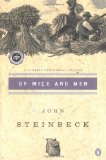This isn’t the first time I’ve read this book, but it is the first time I’ve read it with an eye to notice Steinbeck’s drama-like structure. Almost entirely dialogue and scene description (stage instruction, as it were), this novella is more of a play than was initially obvious to me. It has been the source of several very successful dramatic interpretations–not that it requires much adaptation for such an undertaking.
As such, being dialogue-driven and narrative-sparse, this is not my favorite Steinbeck by a long sight. My appreciation of Steinbeck’s works seems to be directly proportional to their length (with the exception of Cannery Row, but even that gem isn’t my natural pick; it’s simply that it’s obviously a great book).
Add to this that the book’s plot is almost a folk tale at this point–very well-known in our culture–and the reading I did felt less like a literary investigation, more like a rote repetition of something almost ritualistic, mythological. Like a bedtime story I’ve heard many times before. If not comforting, entirely, then familiar.
Full disclosure: The dramatic/play angle of the book wasn’t my own genius interpretation. Susan Shillinglaw’s introduction to the Penguin Classics edition spelled it out for me.

